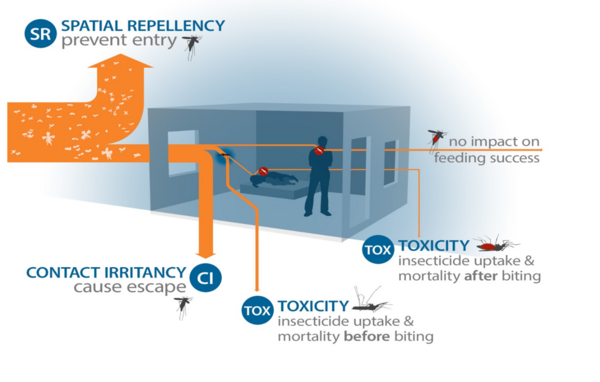Spatial Repellents
How do spatial repellents work?
Spatial repellents release chemicals into the air to prevent mosquitoes from biting humans within a given space--thus helping to prevent disease transmission. Spatial repellents can be used as a repellent or a method for killing mosquitoes. They act via many mechanisms:

- They can prevent mosquitoes from entering a household and therefore reduce the probability that mosquitoes will bite a person who may be inside;
- They can interfere with a mosquito’s ability to detect humans to take a blood meal and therefore produce eggs;
- They can interfere with mating behavior and therefore mosquito’s ability to reproduce; and,
- They can kill mosquitoes.
Overall, the action against the mosquito is determined by the dose of the active ingredient being used and the distance between the product and the mosquito. Since they don’t just kill the mosquito, high doses are not always needed to have an effect. This can reduce the amount of the active ingredient needed while still resulting in reduced biting and/or reduction in mosquito populations due to reduced egg-laying.
What is the public health benefit of spatial repellents?
Spatial repellents have the potential to enhance efforts to control diseases such as malaria and arboviruses (including dengue, Chikungunya and Zika). We expect them to be used with other WHO recommended vector control strategies and fill gaps and/or resolve challenges these strategies are facing when deployed. Used in combination with existing World Health Organization (WHO) recommended vector control methods, spatial repellents could help us achieve our global malaria elimination and eradication goals faster and help reduce the health impact of dengue outbreaks.
For malaria, spatial repellents can be particularly effective when mosquitoes bite during the early evening or early morning when people may not be under long-lasting insecticide nets (LLINs), one of the current WHO recommended strategies for malaria prevention. Spatial repellents may also be effective in places where indoor residual spraying (IRS) (the other WHO recommended vector control strategy for malaria) is challenged due to mosquitoes not resting indoors and/or where structures may not have walls that can be treated with insecticides.
For arbovirus control, which typically occurs in urban areas, spatial repellent products may be able to be distributed as products the homeowner applies in their home themselves, throughout the year, avoiding the need for vector control personnel to enter houses to spray insecticides when people may not be home.
If people are using spatial repellents, can they stop using mosquito nets?
No. Spatial repellents are intended to be used in combination with existing mosquito control strategies, including LLINs and IRS. To close the gap on malaria and arbovirus disease prevention and control, we need all the tools that are proven to be effective. Spatial repellents are meant to add a new tool to our arsenal, not replace existing ones.

Are spatial repellents safe?
The active ingredient used in our spatial repellent product is transfluthrin, a registered chemical commonly found in commercially available household insect control products worldwide. The main formulation types available are mosquito coils and aerosols.
Could mosquitoes develop resistance to transfluthrin?
Resistance primarily relates to the killing action of a chemical. Currently, due to the broad use of pyrethroid chemicals in LLINs and IRS, there is already mosquito resistance throughout many disease endemic settings where the Mosquito ShieldTM, containing the pyrethroid transfluthrin, may be used in the future.
Because spatial repellents function to protect people against mosquito biting through mosquito behavior changes that repel as well as kill, this may mitigate the time for selection pressure on mosquito populations to develop transfluthrin resistance. Spatial repellents have also been shown to continue causing repellent mosquito behaviors in mosquitoes already resistant, but additional data is needed to give confidence this will be true in varied areas where malaria and/or dengue may occur.
In Kenya, we will specifically evaluate the effect of spatial repellents in a study area with insecticide resistant mosquito populations.
